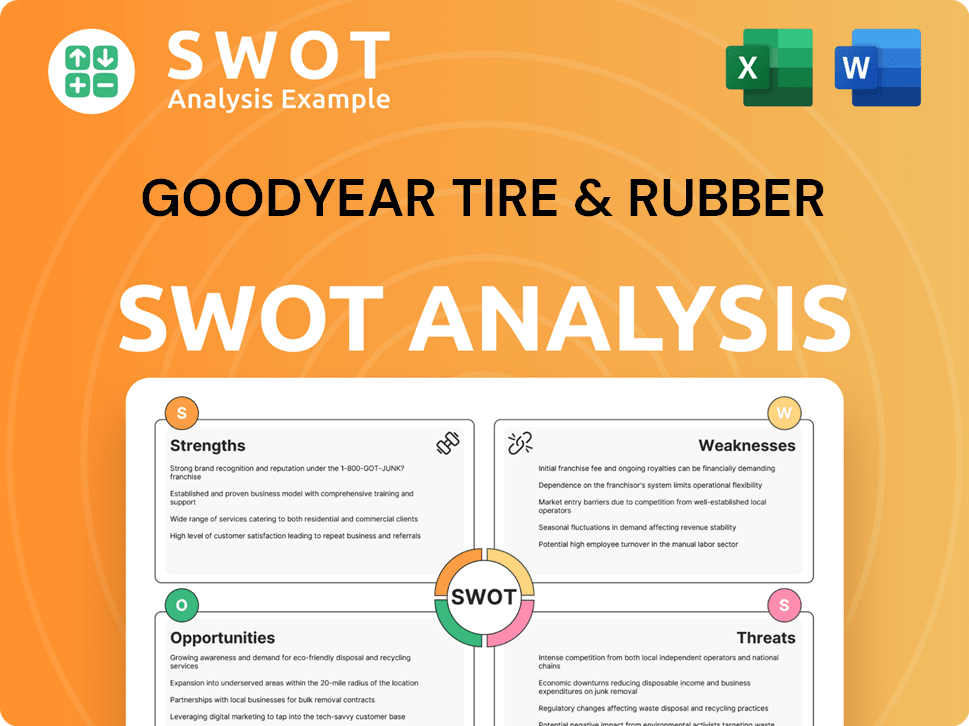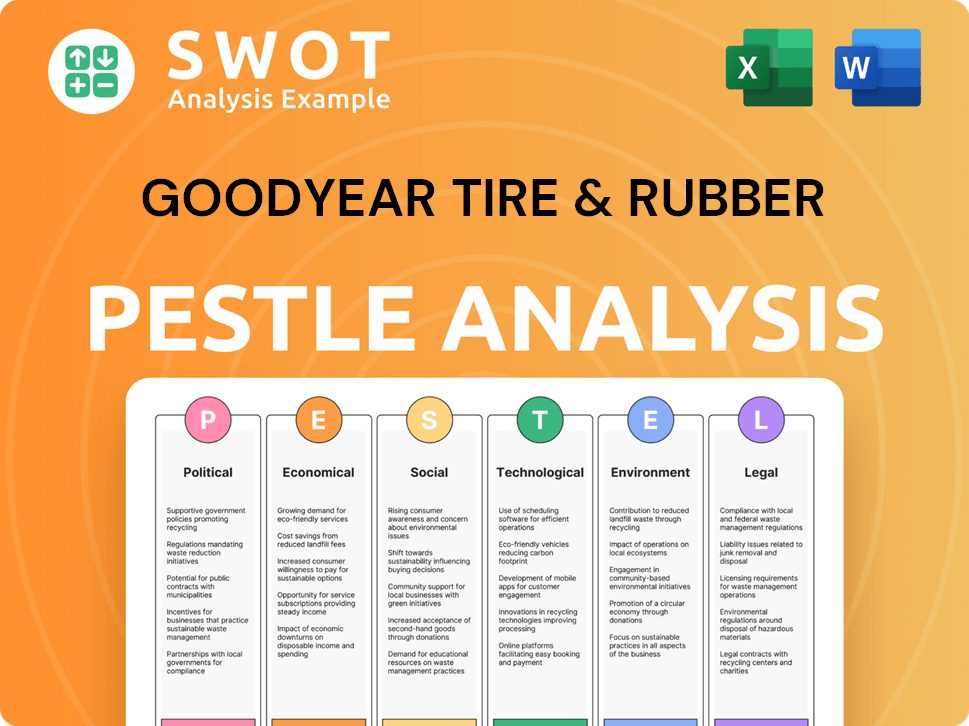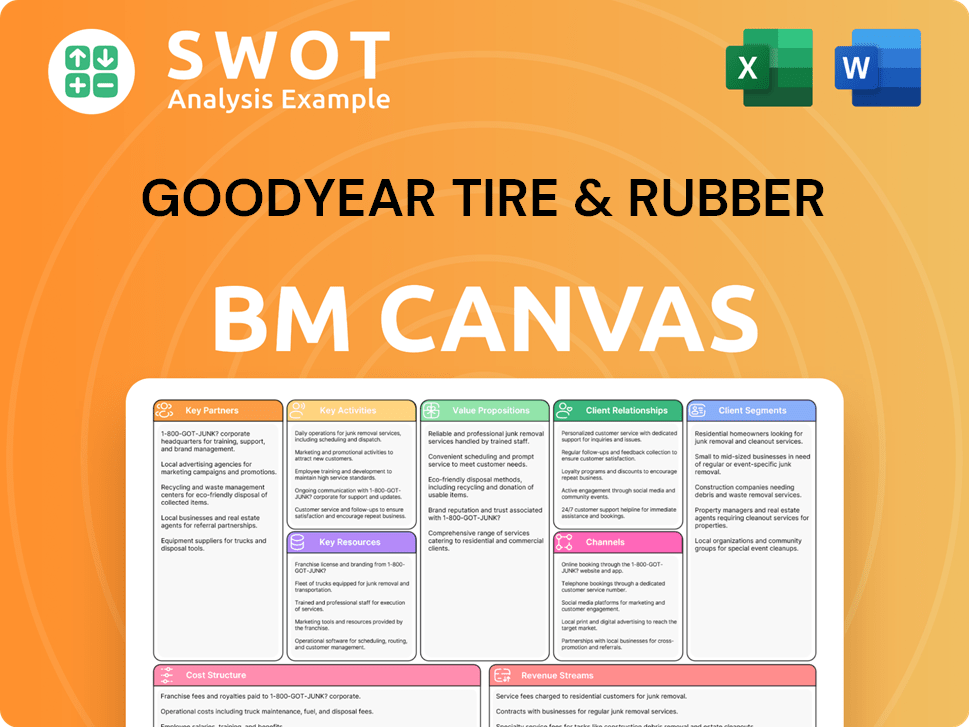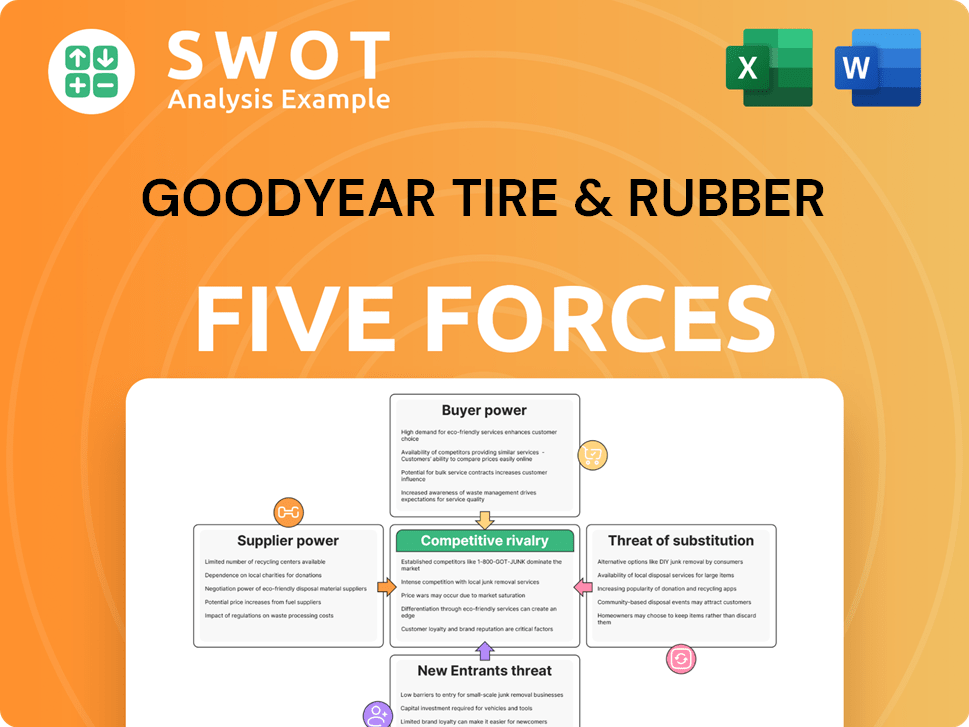Goodyear Tire & Rubber Bundle
Who Really Controls Goodyear Tire & Rubber Company?
Ever wondered who steers the wheel at one of the world's largest tire manufacturers? Understanding the Goodyear Tire & Rubber SWOT Analysis reveals how ownership impacts strategy and performance. Recent strategic shifts, like the sale of its OTR business, underscore the critical role of ownership in shaping a company's destiny. Knowing the answer is key to understanding the Goodyear company's future.

The Goodyear Tire & Rubber Company, a giant in the automotive industry, has a rich Goodyear history dating back to 1898. Knowing the Goodyear ownership structure provides a crucial lens for investors and analysts alike. This exploration will reveal the major shareholders, and how the Goodyear stock has performed, offering valuable insights for anyone tracking the company's financial health and future prospects. Understanding who owns Goodyear is vital to grasping its strategic direction and market positioning in the competitive landscape.
Who Founded Goodyear Tire & Rubber?
The Goodyear Tire & Rubber Company was established on August 29, 1898, in Akron, Ohio. Frank Seiberling founded the company, initially with a capital stock offering of $100,000. This marked the beginning of what would become a significant player in the tire industry.
Frank Seiberling and his brother, C.W. 'Charley' Seiberling, were the driving forces behind the company's initial ventures. They started by manufacturing bicycle and carriage tires, rubber horseshoe pads, and even poker chips. David E. Hill, who invested $30,000, served as the first president, playing a crucial role in the early development of the
A notable early innovation was the patent granted in 1903 to Paul Litchfield for the first tubeless automobile tire. The company quickly pivoted to focus on automobile tires, supplying them to the growing automotive industry, including a portion of Ford's Model T autos. This shift was pivotal in establishing
Initially,
David E. Hill was the first president of
Paul Litchfield received a patent for the first tubeless automobile tire in 1903.
The company quickly transitioned to producing tires for the burgeoning automotive industry.
The initial capital stock offering was $100,000.
Frank Seiberling and his brother C.W. 'Charley' Seiberling founded the
The Seiberling brothers lost control in the early 1920s due to financial difficulties. This led to a reorganization and a shift in
- The company is publicly traded.
- The headquarters is located in Akron, Ohio.
has a diverse portfolio of subsidiaries. faces competition from other major tire manufacturers.
Goodyear Tire & Rubber SWOT Analysis
- Complete SWOT Breakdown
- Fully Customizable
- Editable in Excel & Word
- Professional Formatting
- Investor-Ready Format

How Has Goodyear Tire & Rubber’s Ownership Changed Over Time?
The evolution of Goodyear Tire & Rubber Company's ownership reflects its transition from a privately held entity to a publicly traded company. Goodyear is listed on the Nasdaq Stock Market under the ticker symbol GT. This transformation has led to a diverse shareholder base, with institutional investors holding a significant portion of the company's stock. The company's ownership structure has been shaped by various strategic initiatives and the influence of major stakeholders, including activist investors and institutional holders.
As of May 2025, institutional investors hold approximately 85.68% of Goodyear's stock, while insiders hold 0.47%, and public companies and individual investors hold 28.55%. This demonstrates the substantial influence of institutional investors on the company's strategic direction and governance. Key institutional holders include BlackRock, Inc., The Vanguard Group, Inc., and Wellington Management Group LLP. BlackRock, Inc. is the largest individual shareholder, owning 12.79% of the company as of 2025.
| Stakeholder | Ownership Percentage (as of May 2025) | Shares Held (as of 2025) |
|---|---|---|
| Institutional Investors | Approximately 85.68% | Data Not Available |
| Insiders | 0.47% | Data Not Available |
| Public Companies and Individual Investors | 28.55% | Data Not Available |
| BlackRock, Inc. | 12.79% | 36.54 million |
| iShares | 10.69% | Data Not Available |
| Vanguard | 9.10% | Data Not Available |
Recent years have seen significant strategic shifts impacting Goodyear's portfolio. In May 2023, Elliott Investment Management acquired a 10% stake, initiating a strategic transformation. This led to the 'Goodyear Forward' plan, which includes divesting non-core assets. For example, in February 2025, Goodyear completed the sale of its Off-the-Road (OTR) tire business to The Yokohama Rubber Company, Limited, for $905 million in cash. These divestitures are expected to generate over $2 billion in proceeds, which Goodyear intends to use to reduce leverage and fund further transformation initiatives. To learn more about the company's strategic direction, you can read about the Growth Strategy of Goodyear Tire & Rubber.
Goodyear's ownership is primarily held by institutional investors.
- Institutional investors own a large share of Goodyear stock.
- Activist investors have influenced Goodyear's strategic direction.
- Divestitures are part of the 'Goodyear Forward' plan.
- Goodyear's financial performance is closely watched by shareholders.
Goodyear Tire & Rubber PESTLE Analysis
- Covers All 6 PESTLE Categories
- No Research Needed – Save Hours of Work
- Built by Experts, Trusted by Consultants
- Instant Download, Ready to Use
- 100% Editable, Fully Customizable

Who Sits on Goodyear Tire & Rubber’s Board?
The current leadership of The Goodyear Tire & Rubber Company is spearheaded by Mark Stewart, who serves as the Chief Executive Officer and President, a position he assumed in January 2024. Laurette T. Koellner, the Independent Lead Director since 2019, took on the role of non-executive Board Chair also in January 2024. Mark Stewart joined the board as a director at the same time. The board's composition and leadership structure are pivotal in guiding the strategic direction of the Goodyear company and ensuring effective governance.
The board's structure reflects a commitment to incorporating diverse expertise. While specific voting power details for each board member weren't available, the influence of major shareholders is significant. Institutional investors collectively hold approximately 85.68% of the company's stock as of May 2025. Insider ownership, which includes board members, is around 0.47% as of May 2025. This ownership structure highlights the significant role institutional investors play in board decisions and strategic oversight.
| Board Member | Role | Date of Appointment |
|---|---|---|
| Mark Stewart | Chief Executive Officer and President, Director | January 2024 |
| Laurette T. Koellner | Non-Executive Board Chair | January 2024 |
| Richard J. Kramer | Director | 2008 |
Goodyear maintains a robust shareholder engagement program, demonstrated by meetings with shareholders representing 67% of outstanding shares in 2024. This program covers critical areas such as long-term business strategy, executive compensation, corporate governance, and corporate responsibility. The board's focus on shareholder input and diverse expertise is designed to align with the company's evolving strategy. In May 2023, activist investor Elliott Investment Management acquired a 10% stake, securing three board seats and initiating a strategic transformation, including the 'Goodyear Forward' plan. To learn more about the company's origins, you can read the Brief History of Goodyear Tire & Rubber.
The Board of Directors at Goodyear Tire plays a crucial role in the company's strategic direction and governance.
- Mark Stewart is the current CEO and President.
- Laurette T. Koellner serves as the non-executive Board Chair.
- Institutional investors hold a major portion of the company's stock.
- Shareholder engagement is a key part of Goodyear's governance.
Goodyear Tire & Rubber Business Model Canvas
- Complete 9-Block Business Model Canvas
- Effortlessly Communicate Your Business Strategy
- Investor-Ready BMC Format
- 100% Editable and Customizable
- Clear and Structured Layout

What Recent Changes Have Shaped Goodyear Tire & Rubber’s Ownership Landscape?
Over the past few years, the Goodyear Tire & Rubber Company has been undergoing significant strategic shifts. These changes are largely driven by its 'Goodyear Forward' transformation plan, launched in 2023. The plan aims to optimize the company's portfolio and reduce leverage, targeting $1.5 billion in annual run-rate benefits by the end of 2025. A key aspect of this plan involves portfolio optimization through divestitures, with several sales completed or announced in 2025.
In February 2025, Goodyear completed the sale of its Off-the-Road (OTR) tire business to The Yokohama Rubber Company for $905 million. Additionally, in January 2025, the company announced the sale of its Dunlop brand trademarks in Europe, North America, and Oceania to Sumitomo Rubber Industries Ltd. for $526 million, expected to close by mid-2025. In May 2025, Goodyear also agreed to sell a majority stake in its chemical business to private equity firm Gemspring Capital Management for approximately $650 million, expected to close by late 2025. These divestitures are projected to generate gross proceeds exceeding $2 billion. These strategic moves are aimed at improving the company's financial position and focusing on core business areas.
| Metric | Value (as of May 2025) | Notes |
|---|---|---|
| Institutional Ownership | Approximately 85.68% | Represents the largest share of Goodyear's stock. |
| Insider Ownership | 0.47% | Increased from 0.37% in May 2025. |
| 1-Year Share Buyback Ratio (as of March 2025) | -0.30% | Indicates no significant share buybacks or potential share issuance. |
Goodyear ownership structure is primarily influenced by institutional investors, who hold a significant majority of the stock. Insiders have also slightly increased their holdings. The company's share buyback activity has been limited. The presence of activist investors like Elliott Investment Management has also played a role in accelerating strategic transformations. As part of its deleveraging efforts, Goodyear aims to achieve a net leverage ratio of 2.0x to 2.5x by the end of 2025. For more insights into the company's strategic direction, consider reading about the Growth Strategy of Goodyear Tire & Rubber.
Mark Stewart was elected Chief Executive Officer and President in January 2024, succeeding Richard J. Kramer. Christopher R. Delaney, President of EMEA, took a leave of absence in April 2025. Bill Caldwell, Senior Vice President of Sales and Marketing, is set to retire in June 2025.
Goodyear aims to achieve a net leverage ratio of 2.0x to 2.5x by the end of 2025. The 'Goodyear Forward' plan targets $1.5 billion in annual run-rate benefits by the end of 2025.
Sale of OTR tire business for $905 million. Sale of Dunlop brand trademarks for $526 million. Agreement to sell a majority stake in its chemical business for approximately $650 million. Projected gross proceeds from divestitures exceeding $2 billion.
Institutional investors hold approximately 85.68% of Goodyear stock. Insiders have slightly increased their holdings. The influence of activist investors has played a role in strategic transformations.
Goodyear Tire & Rubber Porter's Five Forces Analysis
- Covers All 5 Competitive Forces in Detail
- Structured for Consultants, Students, and Founders
- 100% Editable in Microsoft Word & Excel
- Instant Digital Download – Use Immediately
- Compatible with Mac & PC – Fully Unlocked

Related Blogs
- What are Mission Vision & Core Values of Goodyear Tire & Rubber Company?
- What is Competitive Landscape of Goodyear Tire & Rubber Company?
- What is Growth Strategy and Future Prospects of Goodyear Tire & Rubber Company?
- How Does Goodyear Tire & Rubber Company Work?
- What is Sales and Marketing Strategy of Goodyear Tire & Rubber Company?
- What is Brief History of Goodyear Tire & Rubber Company?
- What is Customer Demographics and Target Market of Goodyear Tire & Rubber Company?
Disclaimer
All information, articles, and product details provided on this website are for general informational and educational purposes only. We do not claim any ownership over, nor do we intend to infringe upon, any trademarks, copyrights, logos, brand names, or other intellectual property mentioned or depicted on this site. Such intellectual property remains the property of its respective owners, and any references here are made solely for identification or informational purposes, without implying any affiliation, endorsement, or partnership.
We make no representations or warranties, express or implied, regarding the accuracy, completeness, or suitability of any content or products presented. Nothing on this website should be construed as legal, tax, investment, financial, medical, or other professional advice. In addition, no part of this site—including articles or product references—constitutes a solicitation, recommendation, endorsement, advertisement, or offer to buy or sell any securities, franchises, or other financial instruments, particularly in jurisdictions where such activity would be unlawful.
All content is of a general nature and may not address the specific circumstances of any individual or entity. It is not a substitute for professional advice or services. Any actions you take based on the information provided here are strictly at your own risk. You accept full responsibility for any decisions or outcomes arising from your use of this website and agree to release us from any liability in connection with your use of, or reliance upon, the content or products found herein.